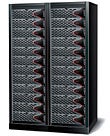Hitachi Data Systems (HDS) has aligned its software and hardware systems more closely with a new initiative dubbed “application optimized storage.”
The push, announced Tuesday, includes a device to fill a gap in the company’s Thunder modular storage system line, along with new software from the company’s HiCommand Storage Area Management Suite.

HDS Thunder 9585V
The new Thunder 9585V is geared for the top of the mid-range market and is primed for applications that require extremely high capacity and the highest performance criteria. The machine is optimized for heavy duty applications such as rich media, data mining, high performance computing (HPC), and large databases.
It capitalizes on the Santa Clara, Calif.-based company’s goal to offer storage systems with common management software, according to Peter Smails, senior director of product marketing at HDS. Analysts say a standard framework simplifies IT management and helps preserve return on investment.
“The customer is increasingly focused on top-line business issues like governance, risk, efficiency, and value, so the challenge for organizations today is creating closer alignment with top-line business issues and the underlying infrastructures those IT organizations are focusing on,” says Smails.
Smails told internetnews.com the same software is used to run the Thunder 9500 V Series and high-end Lightning 9900 V Series, making the Thunder 9585V a key component of an application-optimized tiered storage architecture.
This is unique in a space where vendors write different types of architectures and software to run different grades of hardware. HDS rivals IBM and EMC
, for example, employ different software capabilities to power their mid-range and high-end storage machines.
The 9585, which scales to 64 terabytes, also boasts a 1.3 gigahertz PowerPC chip that is 40 percent faster than previous chips, making the 9585V 47 percent faster (reaching over 240,000 I/O operations per second) than comparable machines from IBM and EMC, claims Smails.
Pricing ranges from $100,000 for a 1TB Thunder 9585V to $300,000 for a 10TB version. HDS customers with Thunder 9580V systems can also move up to the Thunder 9585V system seamlessly with no downtime.
On the software side, HDS has unveiled the latest version of its HiCommand Storage Services Manager, a component of the HiCommand Storage Area Management Suite; HiCommand Path Provisioning; HiCommand QoS for Sybase; and HiCommand Tuning Manager 3.3.
Chief among these upgrades is the HiCommand Storage Services Manager 3.1, which locates storage infrastructure and lights the way for each application through the SAN to the storage system for total capacity and performance management.
“With our storage area management suite we provide, figuratively speaking, a blade approach in the sense that you can run modules on top of our Storage Services Manager,” Smails says. “We provide application-level modules that let you look at the world specifically from the application context.”
Story adapted from Internet News.
Back to Enterprise Storage Forum





